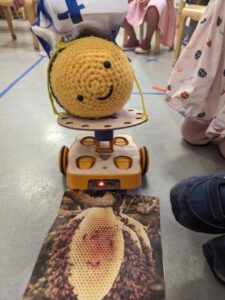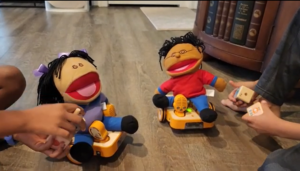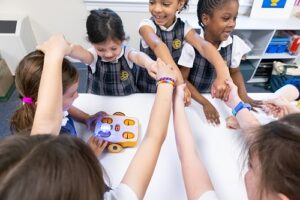Greek Gods and Robotics
Contributed by: Robin Ricketts, Computational Thinking and Robotics Teacher, The Steward School, Richmond, VA), https://stewardschool.org
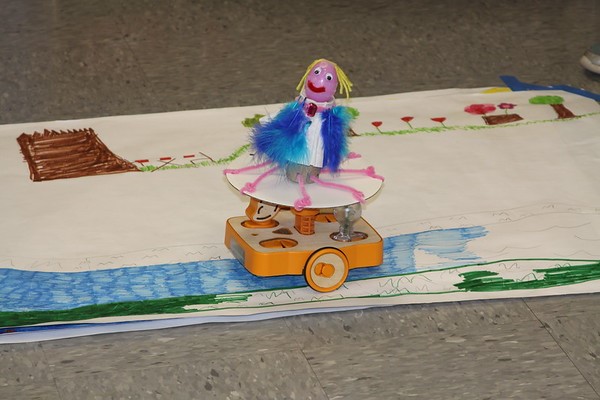
Daedalus and Icarus stand poised to fly away from the island of Crete. Daedalus warns Icarus not to fly too high lest the shining sun melt the wax holding his carefully crafted wings together, or too low where the swirling blue waves of the ocean would dampen his feathers and weigh him down. At the sound of clapping hands, the characters begin their “flight” across a large paper map. Icarus flies higher and higher and then suddenly changes direction and heads for the sea. He spins and beeps and stops on the blue water.
This is all taking place during an integrated STEAM lesson in a second grade classroom. The characters in this Greek myth are made of cardboard tubes, pipe cleaners, feathers, and other craft materials. They sit atop student-assembled robots called KIBOs. The students have written their own versions of familiar myths and programmed the KIBOs to travel through their “story spaces” (giant floor maps they’ve drawn).
I teach computational thinking and robotics at The Steward School in Richmond, VA. and this year we introduced the use of KIBOs in our Lower School classes. These ingenious robotics kits offer young children the chance to design, build, customize, and program robots in many configurations. They include a variety of input sensors and outputs such as sounds and lights. The code is constructed by lining up a series of wooden command blocks, each of which has a command symbol, word, and barcode. Students upload the code to the robot by scanning the barcode on each block.
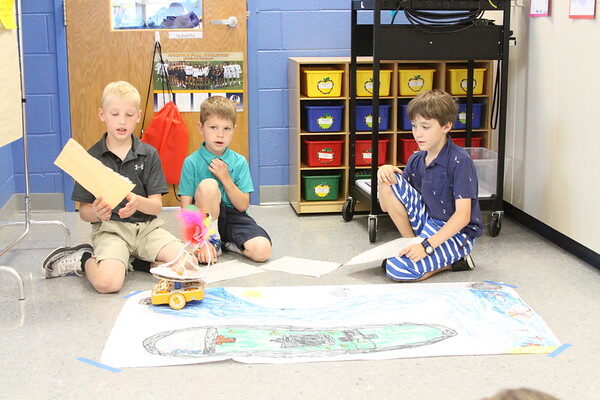 When the second grade teachers asked if we could collaborate on an integrated study of Greek myths, we considered the KIBO’s potential for fostering the engineering design process, creativity, collaboration, and computational thinking and decided they were the perfect tool to tie everything together. We wanted to create an experience that allowed the children to bring their own ideas and creativity to the table to create something that was personally meaningful. This is at the heart of the the constructionist theory of learning developed by Seymour Papert, a computer science and mathematics professor and researcher at MIT. In fact the KIBO robotics kit was developed by Dr. Marina Bers, a student of Dr. Papert and now a Boston College professor specializing in both child development and computer science.
When the second grade teachers asked if we could collaborate on an integrated study of Greek myths, we considered the KIBO’s potential for fostering the engineering design process, creativity, collaboration, and computational thinking and decided they were the perfect tool to tie everything together. We wanted to create an experience that allowed the children to bring their own ideas and creativity to the table to create something that was personally meaningful. This is at the heart of the the constructionist theory of learning developed by Seymour Papert, a computer science and mathematics professor and researcher at MIT. In fact the KIBO robotics kit was developed by Dr. Marina Bers, a student of Dr. Papert and now a Boston College professor specializing in both child development and computer science.
With any skill or concept, if it is taught in isolation, it has less meaning to a child than when the lesson is presented as a problem involving a personal interest or creation. The child naturally has more of a personal investment in this kind of an activity. They build upon a scaffolding of existing knowledge and interests, constructing new knowledge that is personally meaningful. When the lesson is structured this way, their understanding of the subject will go a lot deeper.
To begin our project, the classroom teachers, Enrichment Coordinator/Engineering teacher, and I created a timeline of activities that would culminate in the children retelling a Greek myth, using their custom story spaces and their KIBOs (customized to represent a god or goddess). The students would work in groups of three or four. The plans looked something like this:
Classroom teachers will guide students to:
* Read myths.
* Choose myths for the project.
* Create written scripts to read as the robot god moves through the story space.
* Sketch the story space.
Engineering teacher will guide students to:
* Draw the story space on large sheets of paper.
* Construct the god or goddess that goes on top of the robot platform.
* Construct auxiliary characters, either 2D on map, or 3D to help tell the story.
Computational Thinking and Robotics teacher will guide students to:
* Construct the robots.
* Attach the god or goddess construction.
* Program the robots to travel through the story space maps, stopping at each of the significant locations described in the story script.
Working in groups required the children to practice more than just STEAM skills. They needed to listen to each other; make decisions as a group; combine their ideas and skills to write their myth script, design and create their god or goddess and their map, and construct and program the KIBO.
Each group was given a six-inch circle of corrugated cardboard on which to build their characters. The circle had holes punched around the edge and a piece of velcro on the bottom. The students used pipe cleaners, string, or ribbons to stabilize their character in an upright position on their cardboard platform. The platforms were then velcroed to the plastic KIBO platform. In this way the four KIBOs we own could be used by multiple classes. When the character platforms were attached to the KIBOs and the KIBO programs were run, some groups found they needed to do additional work to stabilize their characters. The final characters showed a wide variety of creative skills and engineering expertise.
When it came to drawing their maps on the large sheets of paper, students had to figure out how to design the map to include locations that, in some cases, involved three-dimensional space. They also had to agree on how to share the responsibilities of drawing the map.
The groups worked together to construct a program that would move their robot through the story space, stopping at the appropriate places and waiting for sound input before continuing. Some groups opted to include sound and light outputs in their program. Some figured out how to incorporate the repeat loop to shorten their program while still accomplishing their goal.
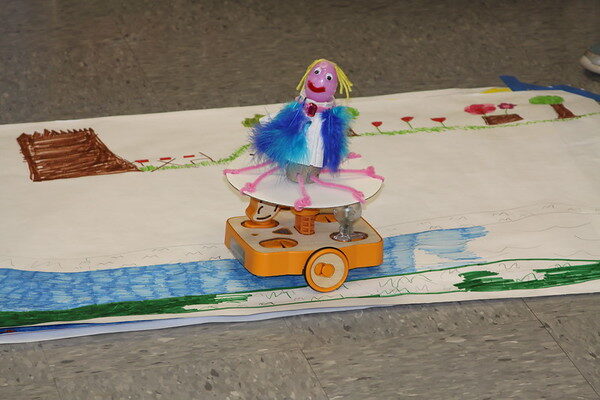 On the final day of the project, students gathered around each story map as the authors ran their KIBO programs and read the accompanying scripts. When everyone was finished, we then allowed time to debrief the whole process, reflecting on the challenges they faced and the strategies they developed to overcome these challenges. To our surprise, almost every group focused on the social-emotional challenges this project presented. They pointed out how important it is to give each member of the group time to express their ideas and their frustrations and to acknowledge in a respectful way that each person is heard and their thoughts are valued. They talked about their strategies for collaborating on story writing, robot construction, map drawing, and how to program the KIBO. They also talked about how to deal with group members whose behaviors they found frustrating.
On the final day of the project, students gathered around each story map as the authors ran their KIBO programs and read the accompanying scripts. When everyone was finished, we then allowed time to debrief the whole process, reflecting on the challenges they faced and the strategies they developed to overcome these challenges. To our surprise, almost every group focused on the social-emotional challenges this project presented. They pointed out how important it is to give each member of the group time to express their ideas and their frustrations and to acknowledge in a respectful way that each person is heard and their thoughts are valued. They talked about their strategies for collaborating on story writing, robot construction, map drawing, and how to program the KIBO. They also talked about how to deal with group members whose behaviors they found frustrating.
We all agreed it was a valuable experience. The new school year began last week and we are already making plans for this year’s integrated KIBO project.
More photos are available here: http://www.stewardsnaps.org/2016-17-School-Year/Lower-School/Grade-2-Greek-Mythology-Robots/



















